FARMING LIQUID GOLD
The joys and perils of a backyard beekeeper
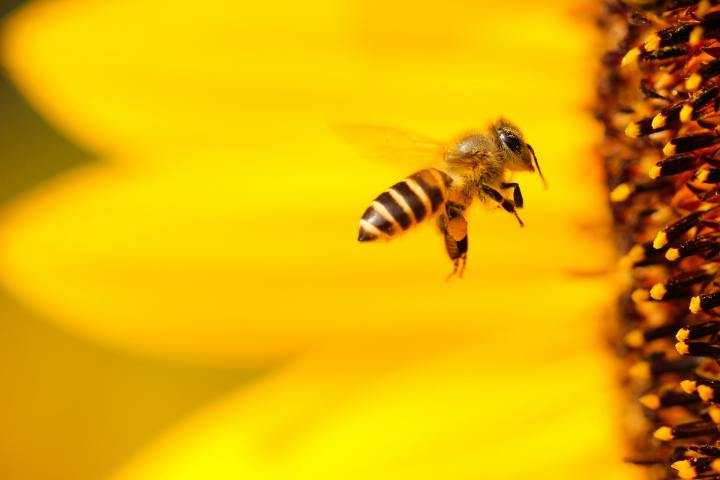
After harvesting the honeycombs and closing the hive, it can take as long as an hour before things calm down and I can sneak back inside without being followed by a frenzied mob. It can be quite unnerving. I should get danger pay.
We became backyard beekeepers for the same reason we became courtyard tomato and butternut farmers, installed rainwater tanks and are saving for ever-more streetwise devices. When asked, we say we are prepping for the Zombie Apocalypse. But it’s really more of a cerebral game: to see how far we can live off-grid in a city.
The thing about bees is that the more you learn about them the more they get to you (same with growing veggies, you soon find). So much depends on them. It’s estimated that around 70 percent of all the food we eat relies on them. Not just bees-pollen-oranges-marmalade, but also clover-sheep-lamb casserole. Even acacia bush-impala-lion, and then hyena-vulture-blowfly-bacteria. The entire wheel of nature is reliant on these busy little flying creatures to keep it rolling. And then there’s the honey, purest and most luscious of all foods.
When you start looking into it, the sheer numbers are humbling. Bees collect pollen to make honey – I think we learned that in primary school. Typically a worker honeybee (they are all females) lives for only about 20 to 30 days. For much of that time each little buzzing fluffball will fly as many as 10 foraging sorties a day, usually no more than five kilometres distant but up to 15 in extreme conditions. They’ll each – 30,000 to 40,000 of them in a colony – visit maybe 100 flowers on each outing, so collecting pollen from some 1,000 flowers a day.
To fill a 500 ml jar of honey (local, pure, of course) around 1,200 bees will have had to visit as many as a million blooms. One worker bee will, in her brief span, contribute maybe a quarter of a teaspoon, roughly 1–2 ml. Problem is, bees worldwide are – along with just about everything else in the great outdoors – taking strain.
In their first week as fully fledged adults the young workers mainly do stuff like keep the hive clean and feed the emerging larvae and pupae in their little honeycomb cells. After about a week they will venture outside, acting first as guardians at the entrances, and then follow the foragers on short sorties. By the end of week two they’ll be hard-working nectar and pollen foragers. Some will become scouts.
The scouts are the first to set out each morning when weather permits (bees hate rain and can get really tetchy when rain clouds gather), seeking out the best forage. They then return to the colony and discuss the options. Thus begins one of nature’s most beguiling performances – the dance of the honeybees.
It was known for ages, literally centuries, that bees did some kind of wiggle-waggle on returning to the hive, although the purpose remained mysterious. In times past honeybees were kept in hollowed logs, large earthenware jars and straw baskets, and in some places still are. Crafting hives from soft agave logs is currently a big thing with artisanal beekeepers.
Anyway, war, which ushers in so much innovation, helped solve the enigma. When artillery bombardments rent Western Europe asunder in 1914, young biologist Karl von Frisch packed his books and microscope in his laboratory in Munich and did a runner for the family’s country seat near Brunnwinkl, a hamlet in the Austrian hills.
Strolling through the meadows there, he became intrigued by the industrious bees, fascinated by their brisk comings and goings. Being a scientist he did what came naturally: he started to study them. One trick he tried, as the little buzzers emerged from their chambers each morning, was daubing them with coloured dots and then racing to and fro to see where they were going and coming from.
He realised that, when the scouts returned, they performed an intricate “dance”, using sunlight (or polarised light if there was none) to plumb a primary bearing. The length of the wiggle indicated to the waiting hordes in what direction they could locate the best forage; the fervour of the waggle gave them the distance; while the zeal of the woggle indicated the quality they could expect to find there. Smart for a little gogga without a backbone and a brain the size of a pinhead. Of course no one else in the bee world believed him, busy as they were tearing up the continent (twice). It took another 59 years before Von Frisch was rewarded with a Nobel Prize in 1973.
There are about 20,000 species of bees found around the world and most of them are small and solitary. Africa is home to roughly 3,000 species, of which about 1,000 can be found in South Africa. They are each vital in the business of pollination, but of all of those only nine species are social and make honey. And only one, Apis mellifera, has been domesticated to give us the surplus flows we so love.
These bees have been the subject of much taxonomical debate over the years, but the current wisdom is that it they all belong to a single species divided into 24 races, which in some literature are afforded the more elevated rank of sub-species (taxonomy being such a scurrilous branch of the sciences). Africa has 10 of them, South Africa just two: the Cape honeybee, A m capensis, that is confined to the fynbos region, and A m scutella that is found throughout most of the tropical African lowlands (known as the African killer bee in the Americas, after they escaped captivity from a research facility in Brazil and raced northwards like swarms of stinging bats out of hell).
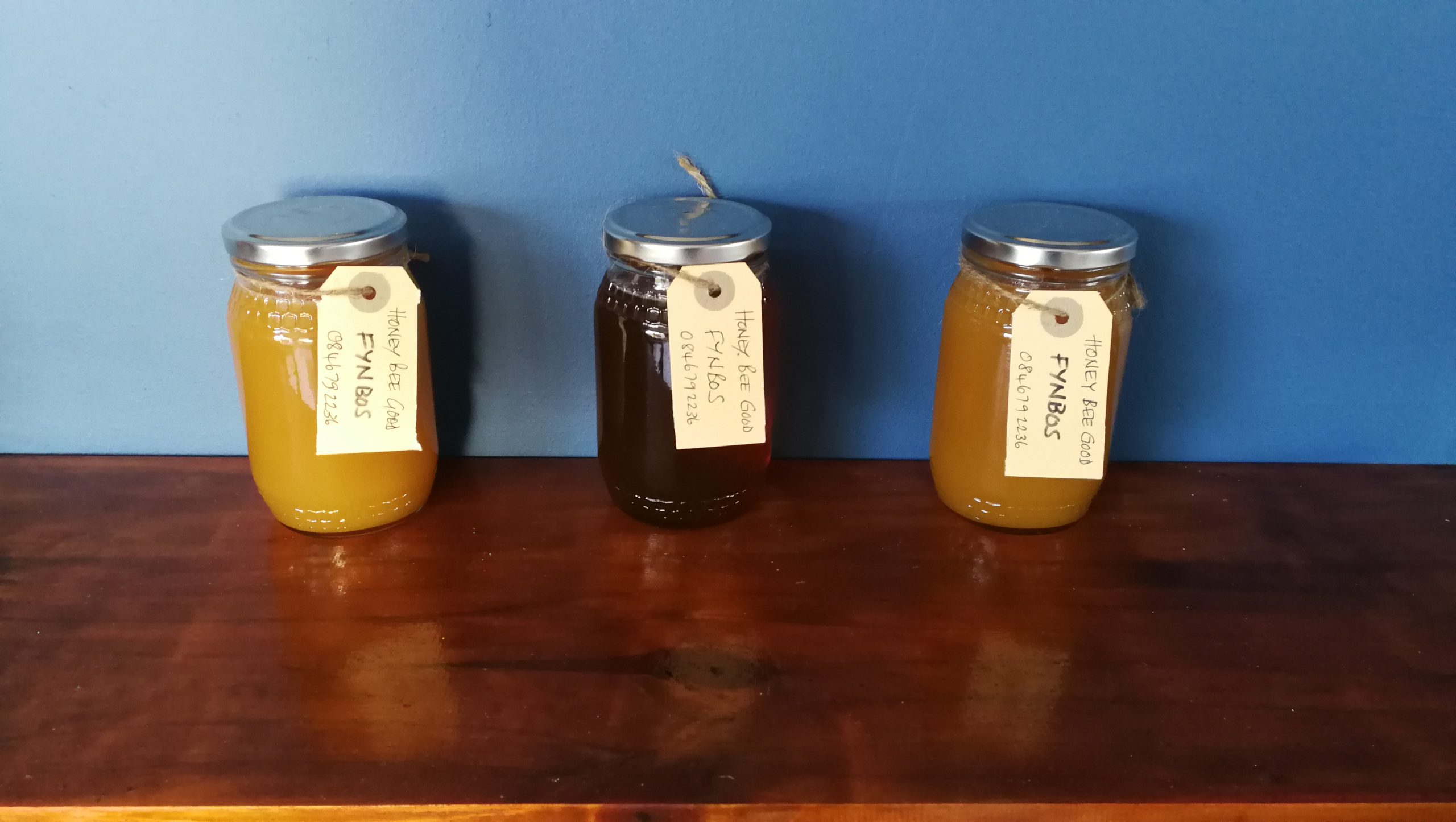
The three jars here have honey from three different hives, each situated in a fynbos area, but clearly from quite different forage. (Photo: Josephine Bestic)
I look after just one hive, which stands in our back garden, as part of a kind of beekeeping collective. Typically it yields about 10kg of liquid gold three times a year. You should only ever take honey when there is good, as they say, flow, because it’s also the colony’s primary source of food. Once enraged by something, like maybe breaking open their home, they’ll work extremely diligently to breach your defences.
When you open a hive (using a smoker to hush them down), they immediately go into distress mode: they are being subjected to a potentially lethal attack. As you attend to the hive they’ll start to poop on you, leaving little mustard-coloured drops that are, by the way, really hard to wash out.
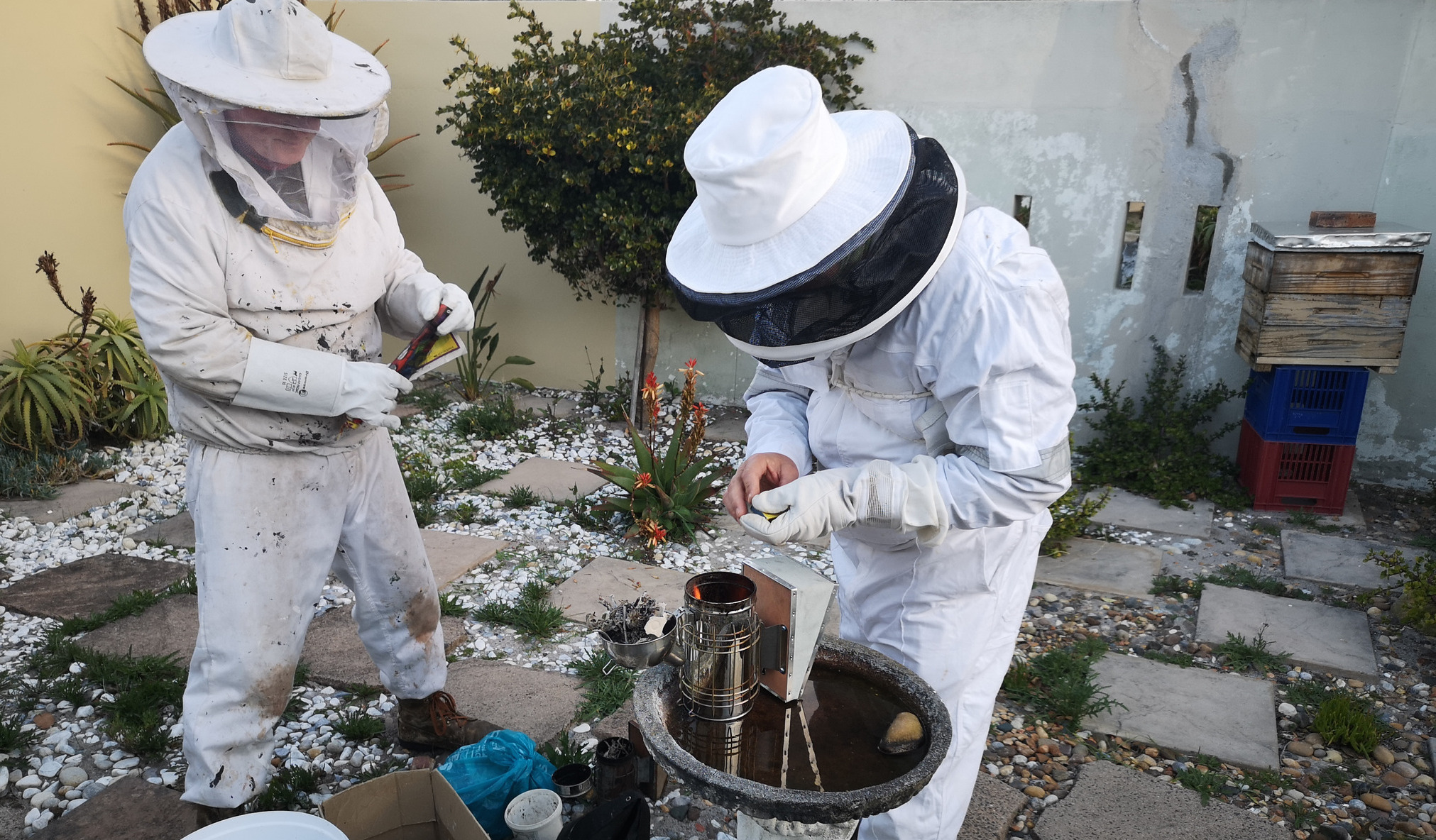
Getting prepped for the harvest – having good smoke is essential. We use dried imphepho, everlastings, which I gather on the mountain. (Photo: Josephine Bestic)
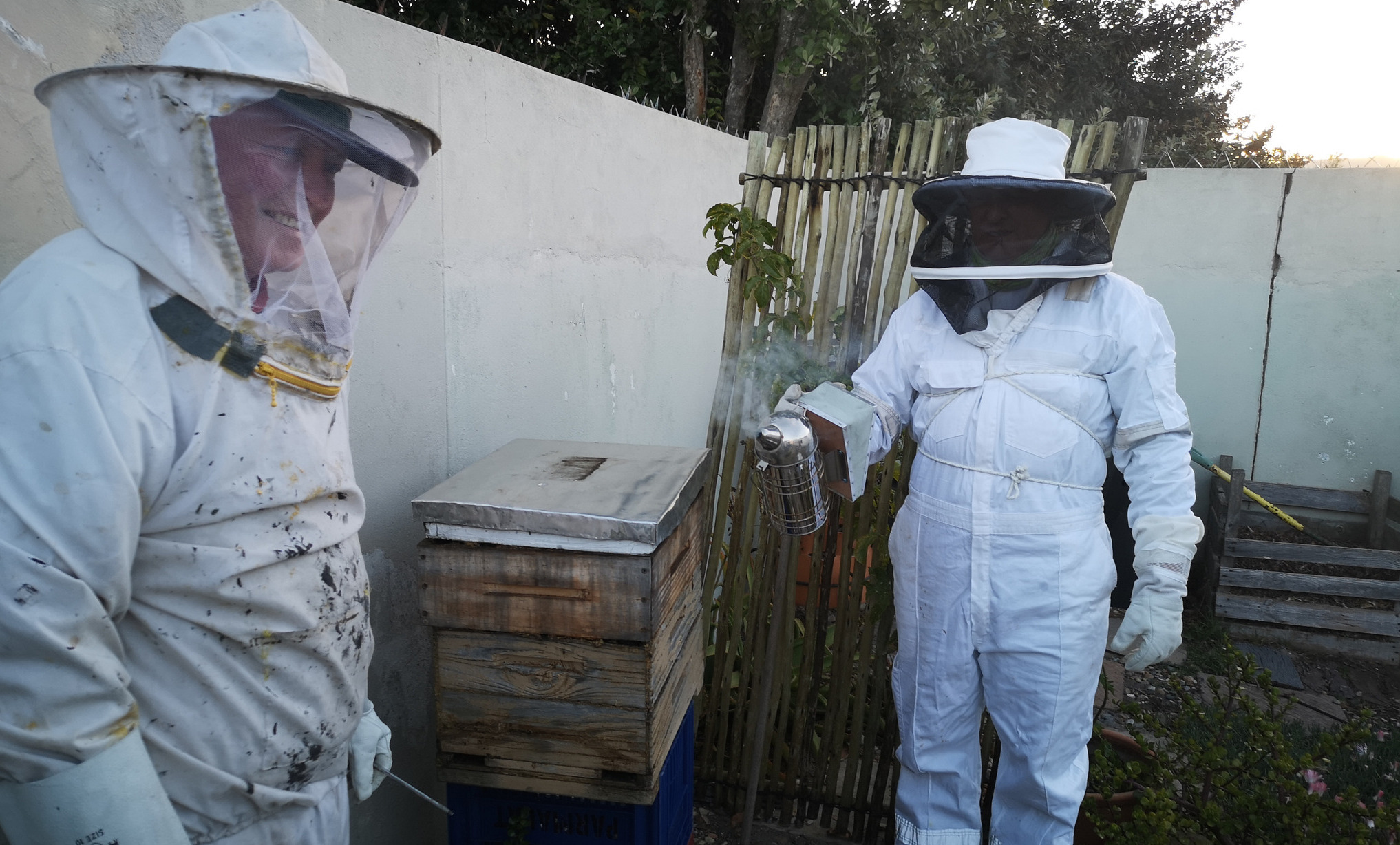
Cool clear weather, check; bee suits, check; smoke, check. My boet Vincent and I ready to go with the honey flow. (Photo: Josephine Bestic)
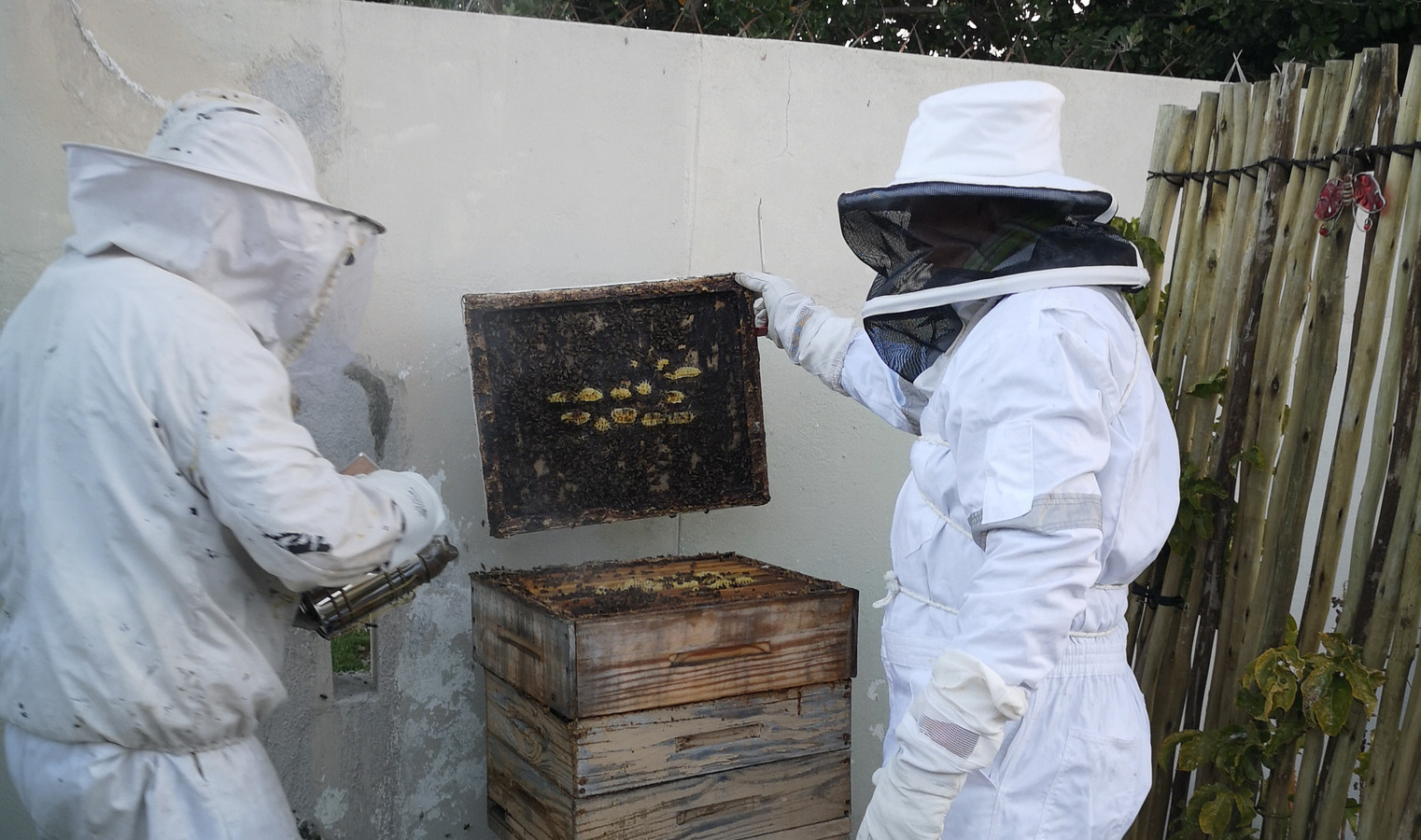
The queen lives in the lower chamber and lays eggs, while honey is taken only from the upper chamber or ‘super’. (Photo: Josephine Bestic)
The pheromones released drive the swarm into a killing mood. After harvesting the honeycombs and closing the hive, it can take as long as an hour before things calm down and I can sneak back inside without being followed by a frenzied mob. If you are not well prepared it can all be quite unnerving. For the danger pay alone, R80 a jar is a real bargain.
The old books tell us it’s a good thing to sit and tell your bees the news, especially the domestic comings and goings. I talk, and sometimes sing, to mine whenever I’m about in the garden. I think it soothes them but my partner reckons my voice just needles them. Some beekeepers are really rough with their little buzzers (“they’re social insects, easy come easy go”). I like to be gentler with mine, feeling guilty for the intrusion and wondering if I should be leaving a small offering for some higher power.
But not all is milk and honey in the land of hives. Some years back a most disquieting phenomenon had beekeepers far and wide in a tizz. Hives were suddenly succumbing to all manner of maladies including varroa mites, tracheal mites, hive beetles (small and large), wax moths, foulbrood, stonebrood, chalkbrood and more, and worse.
A healthy hive can cope with most of these most of the time, although a beekeeper expects to lose one colony every now and again to the vagaries of nature. Apart from their deadly stings, worker bees have another canny trick: they produce an epoxy-like substance called propolis. It’s used mainly to seal the hive and, if it is breached, the workers will swarm the invader and entomb it in a hard ball of this natural resin.
Nobody could figure out what was happening so they named the phenomenon colony “collapse disorder”. In the United States and Germany particularly, commercial honeybee populations declined up to 80%, 90% in extreme cases. It was like an insect Aids epidemic: what was it exactly, where did it come from? It seemed there was some underlying factor that was weakening colonies almost universally. The bee world had been knocked off balance.
Unlike here where we keep bees mainly for their honey, in the bigger bee farming countries like the United States, China and Germany, honey is often just a byproduct of the real business. The big money is in hiring out hives for the pollination of orchards and crops. In the United States some beekeepers no longer bother with primary homes but live in their long-haul horse-and-trailer rigs.
As crops come into bloom across the country – almonds in California, apples on the East Coast, melons in the South (along with the polk salad no doubt) – so the bee truckers arrive en masse and set their little honeymakers off to gather the golden stuff. Interestingly, though, bees have no intention to or, in truth, knowledge of, pollinating flowers: they’re simply after the pollen, otherwise known as bee bread. Helping the plants to procreate is a side service, thank you sir, and pleasure ma’am.
All this is good for the beekeepers and fruit and vegetable farmers, but it’s hell on an industrious insect. It takes a substantial part of a worker bee’s short life to fix its location and learn how to navigate out and back when foraging. They don’t like being moved around at all. But bee-pollination brokers are pretty much always on the move, bumping down highways and byways, which puts their swarms into permanent stress.
Add to that agricultural spraying and exhaust pollution to name a few other sources of irritation. Then cast over all of that a net of radiation from all our various communication networks. The bees have to navigate through this jamming electronic shield whenever they go out to forage; it really messes with their GPSs and makes them thoroughly anxious.
Experiments carried out at the Swiss Institute of Technology found that whenever their test bees were subjected to cellphone waves, they emitted the same kind of piping “mayday” signal they do when you break open their hive. One response is to send the colony into attack mode. Another is to vacate the hive. Colony collapse disorder.
And then there is China, second to the United States in honey production. Some smart geopolitical commentator noted that we have made a deal with them: they’ll make lots of cheap stuff and we’ll buy it, or all hell will break loose. (I did a long mountain biking trip some time back, and in the most remote mountain villages of Lesotho there it was: the Chinese trading store, entrepôt of the new empire.) They are doing the same with their honey.
Most of the supermarket honey you buy (and generally you shouldn’t) comes from China, often via “masking” countries such as Zambia or India. It’s pretty much all made with sugar water rather than pollen. Their honey is hard to tell apart, especially since they add pollen traces to cheat the honey police. It’s like feeding your children entirely on Coke and doughnuts.
Even some of New Zealand’s famed Manuka label, the world’s most expensive honey, at around R650 for a 500 g jar), has been found to contain Chinese honey-water. My own fynbos brand (Dee’s Bees), at just one eighth the price, is as good as – if not better than – that from the land of the long flat vowel. Hundred percent pure guaranteed.
There are plenty of good, local honey producers but very few supply the big chain stores. One local large producer you can depend on is Peel’s, based in the KwaZulu-Natal Midlands.
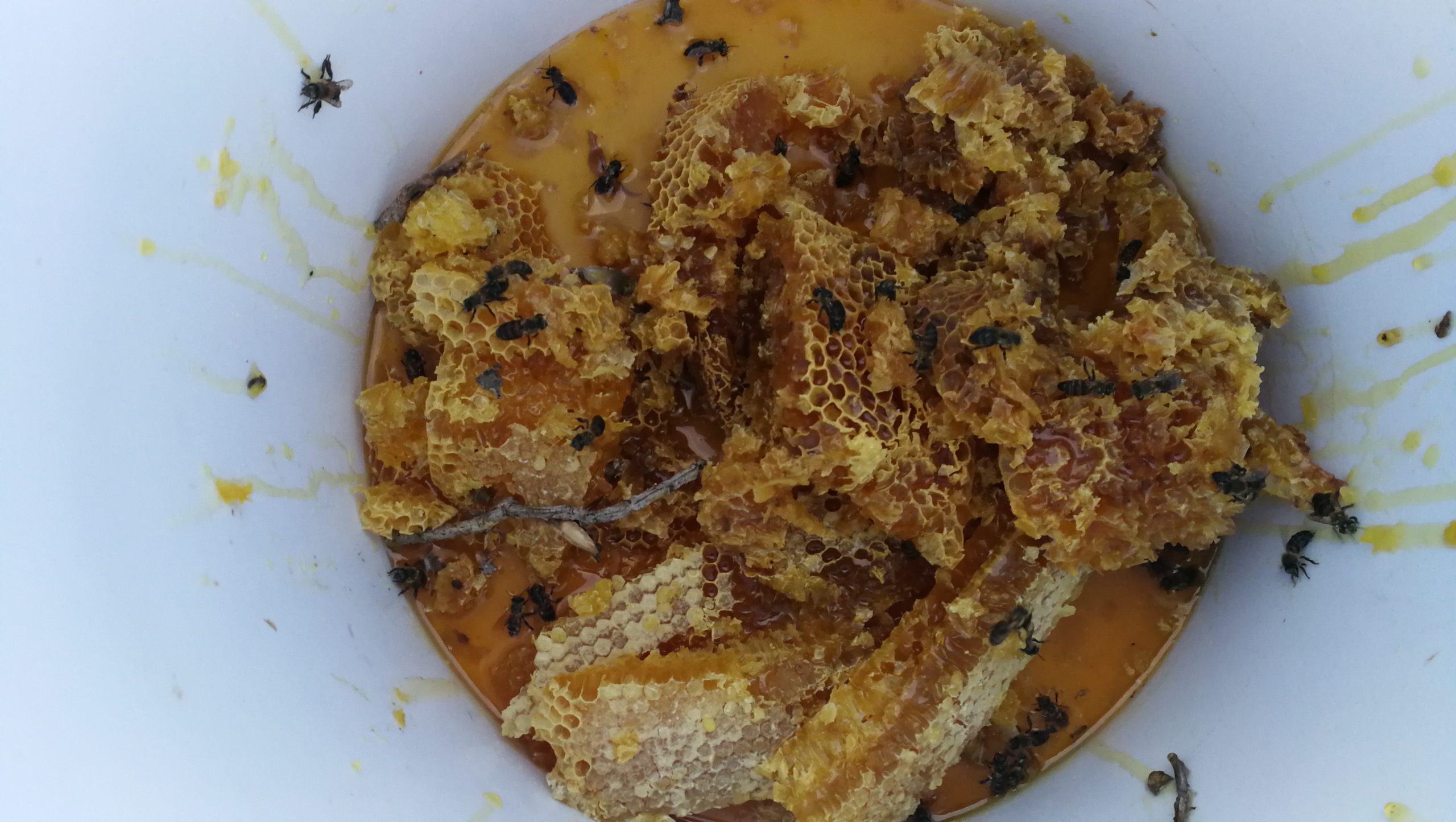
Freshly harvested – mainly – fynbos honey (a few aloes might have been visited in the making thereof). (Photo: Josephine Bestic)
But there are dodgy bee farmers who feed their swarms sugar water to ramp up production and cut costs. It’s not much different from keeping cattle in concrete lots and feeding them mielies, when they have evolved complex guts to eat grass.
A way to counter this kind of scam is to support your local farmer, whether bee, cow or tomato, and to check the food labels. Steer clear of anything that seems to have too many ingredients. For my book Big Pharma, Dirty Lies, Busy Bees and Eco Activists (Jacana Media) I did extensive research on the food, as much as the food additives, industry and what I found was mostly distressing. However, much of the devilish stuff can be found in the details. Once I became fluent in “labelese” I started to buy much smarter. You get better at it with practice. One tool I find indispensible is a pair of strong readers so I can decipher the tiny text.
Still, in some ways we are lucky to have a relatively small commercial bee industry, because the upside is that, unlike most of the rest of the honey sphere, our wild bee populations are mostly in really good health (the Americas and Australasia were not gifted honeybees by the great creator, and have had to import mostly relatively softie European ones).
At a conference in London in 2019, the Royal Geographical Society noted that bees were the most important species on our planet, but that they were increasingly under threat from human-created afflictions. And, basically, that if they go then we all go down with them.
We can all help in small ways, like cultivating more flowering plants while refraining from using herbicides and pesticides. Anyone feeling particularly bold might contemplate ripping out their lawn and sowing a wild meadow in its place. A wonderland of earthly delights awaits down that garden path. DM/TGIFood
SUBSCRIBE: There’s much more from Tony Jackman and his food writing colleagues in his weekly TGIFood newsletter, delivered to your inbox every Friday. Subscribe here. Also visit the TGIFood platform, a repository of all of our food writing.
The writer supports Where Rainbows Meet, an NPO based in Vrygrond, Cape Town. You can support them here.






 Become an Insider
Become an Insider
Comments - Please login in order to comment.